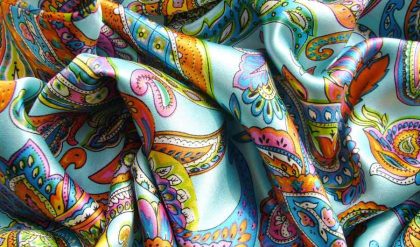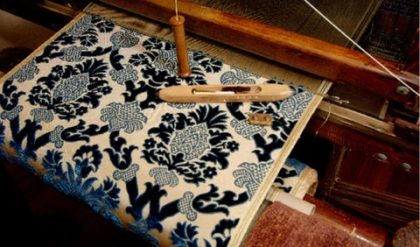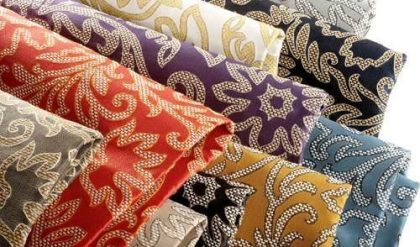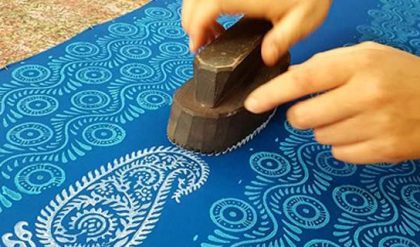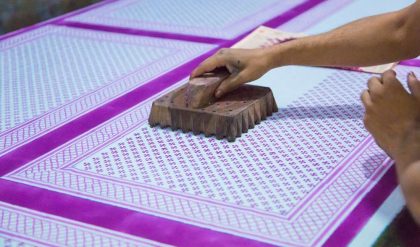Armure
Fibre : Cotton, silk, wool, rayon, synthetics, and blends.
Weave : Plain, twill, or rib, background often has a small design either jacquard or dobby made with warp floats on surface giving a raised effect.
Characteristics : Design is often in two colours and raised. The name was derived from original fabric which was woven with a small interlaced design of chain armor and used for military equipment during the Crusades.
Uses : a rich looking dress fabric, draperies, or upholstery.
Batiste
Fibre : Cotton, also rayon and wool.
Weave : Plain
Characteristics : Named after Jean Baptiste, a French linen weaver. Light weight, soft, semi-sheer fabric which resembles nainsook, but finer. It belongs to the lawn family; almost transparent. It is made of tightly twisted, combed yarns and mercerized finish. Sometimes it is printed or embroidered. In a heavier weight, it is used for foundation garments and linings in a plain, figured, striped, or flowered design. Considered similar to nainsook but finer and lighter in weight. Now usually made of 100% polyester distinguished by slubs in filling direction.
Birdseye
Fibre : In cotton and Linen or blend of rayon staple and cotton.
Weave : Usually dobby
Characteristics : Very soft, light weight, and absorbent. Woven with a loosely twisted filling to increase absorbency. Launders very well. No starch is applied because the absorption properties must be of the best. Material must be free from any foreign matter. It is also called “diaper cloth” and is used for that purpose as well as very good towelling. Also “novelty” birdseye effects used as summer dress fabrics.
Broadcloth
Fibre : Cotton and silk, and rayon. Very different than wool broadcloth.
Weave : Plain weave and in most cotton broadcloths made with a very fine crosswise rib weave.
Characteristics : Originally indicated a cloth woven on a wide loom. Very closely woven and in cotton, made from either carded or combed yarns. The filling is heavier and has less twist. It is finer than poplin when made with a crosswise rib and it is lustrous and soft with a good texture. Thread count ranges from high quality 144 x 6 count down to 80 x 60. Has a smooth finish. May be bleached, dyed, or printed; also is often mercerized. Wears very well. If not of a high quality or treated it wrinkles very badly. Finest quality made from Egyptain or combed pima cotton – also sea island.
Uses : Shirts, dresses, particularly the tailored type in plain colours, blouses, summer wear of all kinds.
Brocade
Fibre : Cotton brocade often has the ground of cotton and the pattern of rayon and silk. Pattern is in low relief.
Weave : Jacquard and dobby
Characteristics : Rich, heavy, elaborate design effect. Sometimes with coloured or metallic threads making the design usually against a satin weave background. This makes the figures stand out. The figures in brocade are rather loose, while in damask the figure threads are actually bound into the material. The pattern may be satin on a twill ground or twill on a satin ground. Often reversible. The motifs may be of flowers, foliage, Scrollwork, Pastoral scenes, or other designs. The price range is wide. Generally reputed to have been developed from the latin name “brocade” which means to figure.
Uses : All types of after 5 wear, church vestments, interior furnishings, and state robes.
Buckram
Fibre : Cotton, some in linen, synthetics.
Weave : Plain
Characteristics : Cheap, low-textured, loose weave, very heavily sized and stiff. Also, 2 fabrics are glued together; one is open weave and the other much finer. Some is also made in linen in a single fabric. Also called crinoline book muslin or book binding. Name from Bokhara in Southern Russia, where it was first made.
Uses : Used for interlinings and all kinds of stiffening in clothes, book binding, and for millinery (because it can be moistened and shaped). Used to give stiffness to leather garments not as stiff and often coloured is called “tarlatan”. Softens with heat. Can be shaped while warm
Calico
Fibre : Cotton
Weave : Plain – usually a low count.
Characteristics : Originated in Calcutta, India, and is one of the oldest cottons. Rather coarse and light in weight. Pattern is printed on one side by discharge or resist printing. It is not always fast in colours. Sized for crispness but washes out and requires starch each time. Designs are often geometric in shape, but originally elaborate designs of birds, trees, and flowers. Inexpensive. Similar to percale. Very little on the market today, but the designs are still in use on other fabrics and sold as “calico print.”
Uses : Housedresses, aprons, patchwork quilts.
Cambric
Fibre : Cotton, also linen.
Weave : Plain
Characteristics : Soft, closely woven, light. Either bleached or piece dyed. Highly mercerized, lint free. Calendered on the right side with a slight gloss. Lower qualities have a smooth bright finish. Similar to batiste but is stiffer and fewer slubs. Launders very well. Has good body, sews and finishes well. Originally made in Cambria, France of linen and used for Church embroidery and table linens.
Uses : Handkerchiefs, underwear, slips, nightgowns, children’s dresses, aprons, shirts and blouses.
Candlewick Fabric
Fibre : Cotton – also wool.
Weave : Plain
Characteristics : An unbleached muslin bed sheeting (also called Kraft muslin) used as a base fabric on which a chenille effect is formed by application of candlewick (heavy plied yarn) loops, which are then cut to give the fuzzy effect and cut yarn appearance of true chenille yarn. May be uncut also. (True chenille is a cotton, wool, silk, or rayon yarn which has a pile protruding all around at slight angles and stimulates a caterpillar. Chenille is the French word for caterpillar.)
Uses : Bedspreads, drapes, housecoats, beach wear.
Canton Flannel
Fibre : Cotton
Weave : Four harness warp-faced twill weave.
Characteristics : The filling yarn is a very loosely twisted and soft and later brushed to produced a soft nap on the back, the warp is medium in size. The face is a twill. Heavy, warm, strong and absorbent. Named for Canton, China where it was first made. Comes bleached, unbleached, dyed, and some is printed.
Uses : Interlinings, sleeping garments, linings, coverings, work gloves.
